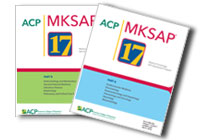 MKSAP has been trusted by internists since 1967 as the best resource for updating knowledge. MKSAP 17, available in Complete, Digital, and Print packages, consists of 11 comprehensive text chapters with related multiple-choice questions. You'll find 1,200 completely new questions to help you identify learning gaps, stay current, and gain the knowledge you need to provide the best possible patient care. MKSAP 17's original and high-quality questions evolve out of case studies and patient scenarios based on the latest evidence.
MKSAP has been trusted by internists since 1967 as the best resource for updating knowledge. MKSAP 17, available in Complete, Digital, and Print packages, consists of 11 comprehensive text chapters with related multiple-choice questions. You'll find 1,200 completely new questions to help you identify learning gaps, stay current, and gain the knowledge you need to provide the best possible patient care. MKSAP 17's original and high-quality questions evolve out of case studies and patient scenarios based on the latest evidence.
For more information on MKSAP 17, or to order your copy, visit mksap17.acponline.org.
MKSAP 17 Q & A
A 79-year-old man is evaluated for a 3-month history of right hip pain. He points to the center of his right buttock when asked to identify the location of the pain. He has no radicular symptoms. He reports no focal trauma but believes his symptoms began after he stepped off a curb that was higher than anticipated. Medical history is otherwise unremarkable. His only medication is as-needed acetaminophen for pain.
On physical examination, vital signs are normal. The general medical examination is unremarkable. There is no tenderness to palpation over the lateral right hip, and he notes mild discomfort when the “dimple” areas of the posterior surface of the buttocks are palpated. There is no pain with passive range of motion of both hips. Straight-leg raise test is negative. When either hip is flexed, abducted, and externally rotated with downward pressure applied to the knee, his pain is reproduced.
Which of the following is the most likely diagnosis?
A: Hip joint osteoarthritis
B: Piriformis syndrome
C: Sacroiliitis
D: Trochanteric bursitis
Click here for the answer and critique.
Back to the July International Newsletter

